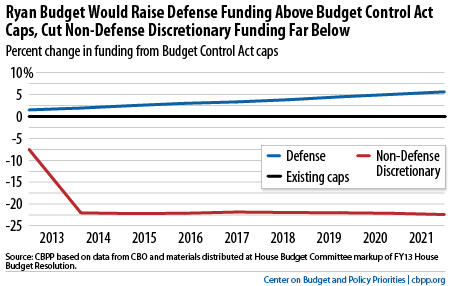BEYOND THE NUMBERS
With defense funding well above the Budget Control Act’s (BCA) funding caps in coming years, and non-defense discretionary funding very far below those caps, House Budget Committee Chairman Paul Ryan’s new budget bears little resemblance to the bipartisan agreement reached last summer (see graph).

Debates over whether the Ryan plan is consistent with the BCA have focused on fiscal year 2013, in which the plan’s total discretionary funding is below the BCA cap. But the Ryan plan departs far more from the BCA over the 2013-2021 period as a whole, shifting large amounts of funding from non-defense discretionary (NDD) programs to defense, while deeply cutting the total (see table). The Ryan budget thereby walks away from the sole significant bipartisan deficit-reduction measure of recent years less than eight months after that measure was negotiated.
| Table 1 | ||||||||||
| Defense Increases, Non-Defense Discretionary (NDD) Cuts Relative to the BCA’s Statutory Funding Caps (In billions of dollars) |
||||||||||
| 2013 | 2014 | 2015 | 2016 | 2017 | 2018 | 2019 | 2020 | 2021 | TOTAL | |
| Defense | 8 | 11 | 14 | 17 | 20 | 23 | 28 | 32 | 36 | 189 |
| NDD | -38 | -115 | -118 | -120 | -120 | -124 | -127 | -130 | -135 | -1,026 |
| Total | -30 | -104 | -104 | -102 | -101 | -100 | -99 | -98 | -98 | -837 |
| Note: Figures may not add due to rounding. | ||||||||||
The Ryan plan would breach the BCA caps on defense funding by $189 billion over the 2013-2021 period, bringing defense funding more than 5 percent above the level set by law. And it would cut NDD funding by more than $1 trillion below the existing funding caps; in 2021, NDD funding would be 23 percent below the cap. (Technically, the BCA has three NDD caps for each year to reflect three different aspects of NDD funding; our figures here combine the three.)
NDD covers all non-defense funding other than for “entitlement” programs, such as Social Security and Medicare. It thus covers a vast array of federal activities: biomedical and scientific research; veterans’ health care; most education; law enforcement and border patrols; national parks and forests; environmental protection; housing assistance; Head Start; job training; NASA; food, drug, workplace, and consumer product safety; and the Treasury, for example.
The caps discussed here do not reflect the automatic cuts (or “sequestration”) that the BCA calls for given the failure of last year’s “supercommittee” to recommend further deficit reduction. But the Ryan plan’s NDD cuts are so deep that they would bring NDD funding 16 percent to 18 percent below the scheduled post-sequestration level from 2014 through 2021.
Some may argue that the Ryan budget does not violate last summer’s deal because the NDD caps are not floors; in other words, it would not breach the law for Congress to appropriate less than the cap, only more. But claiming that last summer’s agreement could legally permit any funding level for NDD programs between zero and the caps — such as a level so low that it would require eliminating Pell grants, the FBI, or veterans’ health care, for example — is a technicality. Such an outcome clearly is not what President Obama and many other congressional leaders thought they had negotiated last August.
More importantly, the Ryan budget clearly does breach the defense caps — and by a lot. If policymakers believe that difficult bipartisan deals will be discarded only months after being worked out, then bipartisan agreements will become even harder to reach than they already are.
